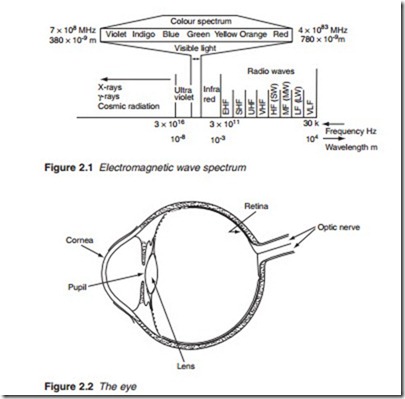Colour television
The first problem facing the transmission of colour TV signals is compatibility with the existing monochrome transmission. When colour television was first introduced, it was agreed that colour TV signals must be capable of producing a normal black and white image on a monochrome receiver without any modification to the television set. Conversely, a colour receiver must be capable of producing a black and white image from a monochrome signal. A colour transmission system must therefore retain the monochrome information, sync pulses and the sound inter-carrier in the same form as those of normal monochrome transmission. The addi- tional colour information has to be included within the composite video signal without interfering with it. Furthermore, the colour signal must fall within the same bandwidth as that allocated for monochrome transmission. To understand how this may be done, we must first look at the properties of light and colour.
Light and colour
We know radio and TV broadcasts are electromagnetic waves of various frequencies and various broadcast bands have already been mentioned in Chapter 1. As we go up in frequency we pass through the bands allotted to radio transmissions, followed by terrestrial TV broadcast and space communications. Way beyond these we come into an area where electro- magnetic radiation is manifest as heat, and continuing upwards we find infra-red radiation, and then a narrow band (between approximately 4 X 108 and 8 X 108 MHz) of light energy. Beyond the ‘light band’ we pass into a region of ultra-violet radiation, X-rays, gamma-rays and then cosmic rays (Figure 2.1). Thus, light is just another electromagnetic wave.
The sensation of colour
Light waves falling on the eye pass through the pupil, which focuses the image on the retina at the back of the eye (Figure 2.2). The retina is sensitive to electromagnetic waves within the visible band; it can therefore translate the electromagnetic energy into suitable information, which is then passed to the brain via numerous optic nerve fibres.
The retina contains a large number of light-sensitive cells. Cells known as rods are sensitive to brightness (or luminance) only; cells known as
cones are sensitive to colour (or chrominance) only. Rods outnumber cones by a factor of 20 and they are 10,000 times more sensitive. The eye therefore reacts predominantly to the luminance content of an image, much more than to its chrominance. This is the reason for high video frequencies with fine picture details are perceived in black and white only.
